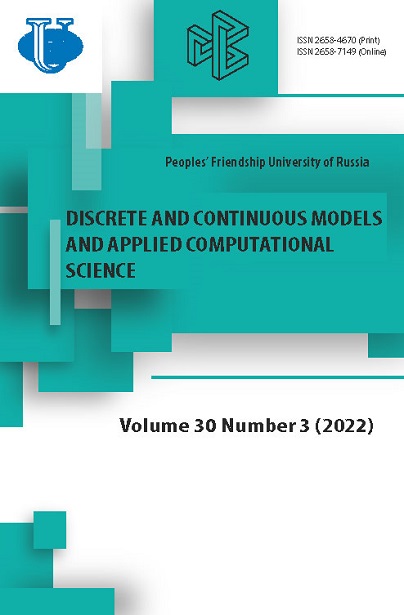Том 30, № 3 (2022)
- Год: 2022
- Статей: 5
- URL: https://journals.rudn.ru/miph/issue/view/1584
- DOI: https://doi.org/10.22363/2658-4670-2022-30-3
Весь выпуск
О применении метода Фурье для решения задачи коррекции термографических изображений
Аннотация
Работа посвящена построению вычислительных алгоритмов, реализующих метод коррекции термографических изображений. Коррекция осуществляется на основе решения некоторой некорректно поставленной смешанной задачи для уравнения Лапласа в цилиндрической области прямоугольного сечения. Эта задача соответствует задаче аналитического продолжения стационарного распределения температуры как гармонической функции с поверхности исследуемого объекта в сторону источников тепла. Цилиндрическая область ограничена произвольной поверхностью и плоскостью. На произвольной поверхности измеряется (и таким образом, задано) распределение температуры, называемое термограммой и воспроизводящее изображение внутренней тепловыделяющей структуры. На этой поверхности - границе исследуемого объекта - имеет место конвективный теплообмен с внешней средой заданной температуры, который описывается законом Ньютона. Это третье краевое условие, которое в совокупности с первым краевым условием соответствует заданию условий Коши - граничным значениям искомой функции и ее нормальной производной. Задача некорректно поставлена. В статье применением метода регуляризации Тихонова получено приближённое решение поставленной задачи, устойчивое по отношению к погрешности к данным Коши, и которое может быть использовано для построения эффективных вычислительных алгоритмов. В работе рассматриваются алгоритмы, позволяющие существенно уменьшить объем вычислений.
 205-216
205-216


Численное моделирование холодной эмиссии в коаксиальном диоде с магнитной изоляцией
Аннотация
В связи с появлением и активным развитием новых областей применения мощных и сверхмощных электровакуумных приборов СВЧ возрос интерес к изучению особенностей поведения ансамблей заряженных частиц, движущихся в пространстве взаимодействия. Примером является пучок электронов, формируемый в коаксиальном диоде с магнитной изоляцией. Численное моделирование эмиссии в таком диоде традиционно проводится с помощью методов типа «частица в ячейке». Они основаны на одновременном расчете уравнений движения частиц и уравнений Максвелла для электромагнитного поля. В данной работе предложен новый вычислительный подход, названный методом точечных макрочастиц. В нем движение частиц описывается уравнениями релятивистской механики, а для полей выписываются явные выражения в квазистатическом приближении. Выполнены расчеты формирования релятивистского электронного пучка в коаксиальном диоде с магнитной изоляцией и проведено сравнение с известными теоретическими соотношениями для скорости электронов в пучке и для тока пучка. Получено отличное согласование результатов расчета с теоретическими формулами.
 217-230
217-230


Применение метода продолженных граничных условий к решению задач дифракции на различных типах частиц сложной структуры
Аннотация
В статье рассмотрено применение метода продолженных граничных условий к двумерной задаче дифракции электромагнитных волн на диэлектрическом теле с поперечным сечением сложной геометрии и к задаче дифракции на сфере Януса в виде проницаемого шара, частично покрытого абсолютно мягким или абсолютно жёстким сферическим экраном. Получены результаты расчёта диаграммы рассеяния для большого набора тел разной геометрии, в том числе фракталоподобных рассеивателей. Проиллюстрировано, что в случае гладкой границы тела алгоритм на основе уравнений Фредгольма 1-го рода позволяет получать результаты с большей точностью, чем для уравнений 2-го рода. Корректность метода подтверждена при помощи проверки выполнения оптической теоремы для различных тел и путём сравнения с результатами расчётов, полученных другими методами.
 231-243
231-243


Разработка и анализ моделей гистерезисного управления миграцией сервисов на сервер граничных вычислений
Аннотация
Сервисы онлайн-видео являются одними из самых популярных способов потребления контента. На серверы видео хостинга приходится ежедневно колоссальная нагрузка, которую нами предложено снизить за счёт миграции приложения востребованным видеоконтентом на локальный сервер MEC целевой зоны. Это позволит повысить качество предоставляемых услуг пользователям за счёт сокращения задержки на передачу. Поэтому предложена архитектура, дающая возможность в моменты повышенного спроса на одинаковый видеоконтент производить миграцию приложения видеосервиса на граничные серверы оператора сети. Для оценки показателей эффективности такого подхода была построена математическая модель в виде системы массового обслуживания. Результаты численного эксперимента позволяют произвести оптимизацию времени использования локальных серверов MEC для предоставления видеоконтента.
 244-257
244-257


Обнаружение кибератак на интеллектуальные энергосистемы с использованием неконтролируемых моделей глубокого обучения
Аннотация
Современные интеллектуальные энергосети объединяют передовые информационные и коммуникационные технологии в традиционные энергосистемы для более эффективного и устойчивого снабжения электроэнергией, что создаёт уязвимости в их системах безопасности, которые могут быть использованы злоумышленниками для проведения кибератак, вызывающих серьезные последствия, такие как массовые перебои в подаче электроэнергии и повреждение инфраструктуры. Существующие методы машинного обучения для обнаружения кибератак в интеллектуальных энергетических сетях в основном используют классические алгоритмы классификации, которые требуют разметки данных, что иногда сложно, а то и невозможно. В данной статье представлен новый метод обнаружения кибератак в интеллектуальных энергетических сетях, основанный на слабых методах машинного обучения для обнаружения аномалий. Полуконтролируемое обнаружение аномалий использует только экземпляры обычных событий для обучения моделей обнаружения, что делает его подходящим для поиска неизвестных событий атак. В ходе исследования был проанализирован ряд популярных методов обнаружения аномалий с полууправляемыми алгоритмами с использованием общедоступных наборов данных о кибератаках на энергосистемы для определения наиболее эффективных из них. Сравнение производительности с популярными управляемыми алгоритмами показывает, что полууправляемые алгоритмы лучше способны обнаруживать события атак, чем управляемые алгоритмы. Наши результаты также показывают, что производительность полуконтролируемых алгоритмов обнаружения аномалий может быть дополнительно улучшена за счёт усовершенствования модели глубокого автоэнкодера.
 258-268
258-268
















